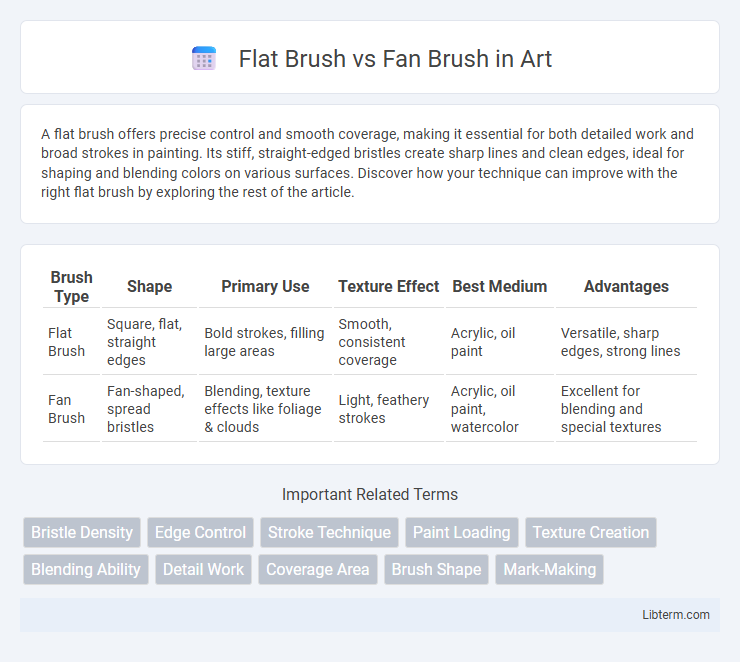A flat brush offers precise control and smooth coverage, making it essential for both detailed work and broad strokes in painting. Its stiff, straight-edged bristles create sharp lines and clean edges, ideal for shaping and blending colors on various surfaces. Discover how your technique can improve with the right flat brush by exploring the rest of the article.
Table of Comparison
| Brush Type | Shape | Primary Use | Texture Effect | Best Medium | Advantages |
|---|---|---|---|---|---|
| Flat Brush | Square, flat, straight edges | Bold strokes, filling large areas | Smooth, consistent coverage | Acrylic, oil paint | Versatile, sharp edges, strong lines |
| Fan Brush | Fan-shaped, spread bristles | Blending, texture effects like foliage & clouds | Light, feathery strokes | Acrylic, oil paint, watercolor | Excellent for blending and special textures |
Introduction to Flat and Fan Brushes
Flat brushes feature a broad, rectangular shape with firm bristles ideal for creating sharp edges and bold strokes, making them perfect for filling large areas and precise linear work. Fan brushes have a unique, spread-out bristle arrangement shaped like a fan, designed for blending, smoothing, and creating texture such as foliage or hair in painting. Both brushes serve distinct functions, with flat brushes offering control and coverage while fan brushes excel in softening and special effects.
Key Differences Between Flat and Fan Brushes
Flat brushes feature a broad, rectangular shape with densely packed bristles, ideal for creating sharp edges and bold, even strokes often used in acrylic and oil painting. Fan brushes have a spread-out, thin bristle arrangement designed for blending, smoothing, and creating textures such as foliage, clouds, or hair with softer, feathered effects. The key differences lie in their shape and bristle density, where flat brushes provide precision and coverage, while fan brushes excel in subtle transitions and detailed texture work.
Design and Structure Comparison
Flat brushes feature a rectangular shape with densely packed bristles arranged in a flat, straight edge ideal for bold, even strokes and sharp lines. Fan brushes have fanned-out bristles spread in a thin, flat profile designed for blending, smoothing, and creating texture such as foliage or hair. The structural difference lies in the bristle arrangement: flat brushes have bristles aligned parallel for coverage and precision, while fan brushes have splayed bristles for soft, feathered effects.
Best Uses for Flat Brushes
Flat brushes excel in creating bold, precise strokes and filling large areas with consistent color, making them ideal for backgrounds and sharp-edged shapes. Their stiff bristles provide excellent control for techniques like blending, glazing, and creating straight lines. Artists frequently rely on flat brushes for both acrylic and oil painting when defining structure and adding layers.
Ideal Applications for Fan Brushes
Fan brushes excel in blending and softening edges, making them ideal for creating delicate textures in landscapes, such as foliage and grass. Their unique shape allows artists to produce subtle, feathery strokes that mimic natural patterns in skies and water reflections. This versatility makes fan brushes a preferred tool for detailed work in both acrylic and oil painting techniques.
Techniques Achievable with Flat Brushes
Flat brushes enable bold, sweeping strokes and precise edge work, ideal for creating sharp lines and filling large areas efficiently. Their versatile shape supports techniques such as blending gradients, creating textured patterns, and applying glazes smoothly. Artists often use flat brushes for structured compositions, layering, and controlled washes that demand consistent, even coverage.
Artistic Effects Created with Fan Brushes
Fan brushes create unique textures and patterns ideal for painting natural elements like foliage, grass, and clouds due to their spread-out bristles and flexible shape. Unlike flat brushes that produce uniform strokes, fan brushes allow artists to achieve soft blending, stippling, and feathering effects, enhancing depth and realism in landscapes. Their ability to create varied marks with a single stroke makes them indispensable for impressionistic and textural painting techniques.
Choosing the Right Brush for Your Painting Style
Selecting the right brush depends on your painting style and desired effects; a flat brush offers sharp edges and broad strokes ideal for bold shapes, while a fan brush excels in creating textured effects like foliage and blending. Flat brushes provide control for precise lines and smooth color application, making them suitable for detailed work or geometric compositions. Fan brushes facilitate soft transitions and natural textures, perfect for landscapes or impressionistic techniques, helping artists achieve dynamic, organic visuals.
Maintenance and Care for Flat vs Fan Brushes
Flat brushes require thorough cleaning after each use to prevent paint buildup along the flat bristles, which can cause them to splay and lose shape. Fan brushes need gentle cleaning with warm water and mild soap, ensuring the bristles retain their delicate, spread-out form and avoid bending or fraying. Proper drying by reshaping bristles and storing brushes upright or flat prolongs the lifespan of both flat and fan brushes.
Conclusion: Which Brush Should You Choose?
Flat brushes excel in creating sharp edges and filling large areas with smooth, consistent strokes, making them ideal for detailed work and coverage. Fan brushes are perfect for blending, softening edges, and adding textured effects such as grass or fur in paintings. Choose a flat brush for precision and coverage, while a fan brush is best for texture and blending techniques in your artwork.
Flat Brush Infographic

 libterm.com
libterm.com